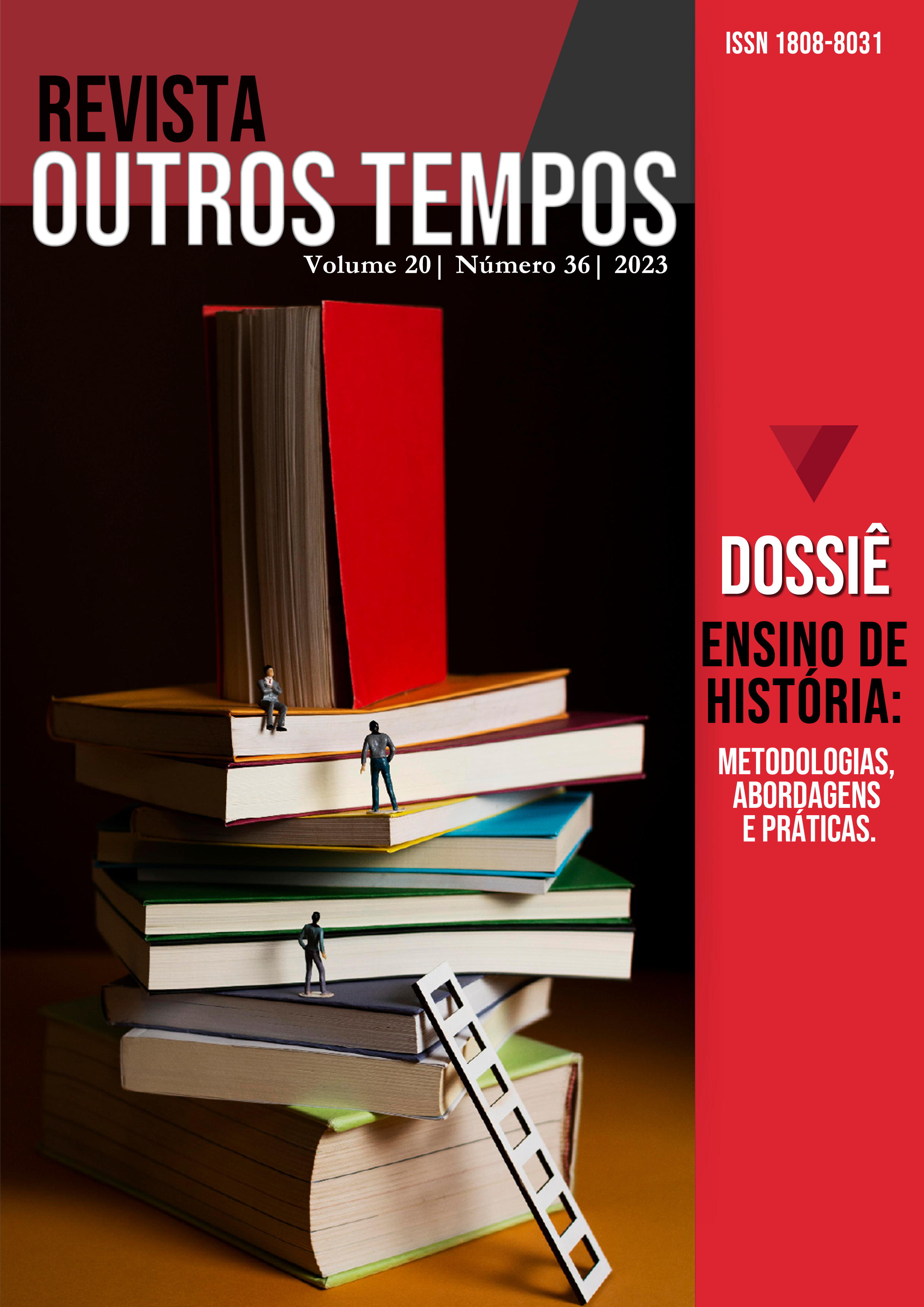CANNON, THE SPY WHO DIDN'T LOVE: espionage and the male imaginary in the Cold War (1970-1973)
DOI:
https://doi.org/10.18817/ot.v20i36.1008Keywords:
Cold War, Male imaginary, Comic stripsAbstract
The aim of this paper is to examine how the comic book strips of the US superspy John Cannon, created by Wallace Wood and published between 1970 and 1973, are inserted in the historical context of the Cold War. We focus on the anti-communist dimension presented in the character's stories and how it dialogues with visual forms and narrative schemes that are expressed through the figure of the objectified women playing the role of the “femmes fatales”. The analysis of this historical source category is revealing of a projected imaginary about the tensions between the United States and its communist enemies, as well as providing us with elements to interpret a possible orientation of the comic strips created by Wallace Wood to the taste of a male audience.
Downloads
References
BACZKO, Bronislaw. Imaginação social. In: ENCICLOPÉDIA Einaudi, volume 5: Anthropos/Homem. Lisboa: Imprensa Nacional: Casa da Moeda, 1985. p. 296-332.
BAKER, Brian. Masculinity in fiction and film: representing men in popular genres 1945-2000. London; New York: Continuum, 2006.
CLUNE, Lori. Executing the Rosenbergs: Death and Diplomacy in a Cold War World. NY: Oxford University Press, 2016.
COSTELLO, Matthew J. Secret Identity Crisis: Comic Books and the Unmasking of Cold War America. New York: Continuum International Publishing Group, 2009.
CROWLEY, David. Posters of the Cold War. London: V & A Publishing, 2008.
EISNER, Will. Narrativas Gráficas. São Paulo: Devir, 2005.
GITLIN, Todd. The Sixties: Years of Hope, Days of Rage. New York: Bantam Books, 1993.
GROENSTEEN, Thierry. Systéme de la bande dessinée. Paris: Presses Universitaries de Frances, 1999.
GROSSMAN, Julie. The femme fatale. New Brunswick; New Jersey: Rutgers University Press, 2020.
HADJU, David. The Ten-Cent Plague: The Great Comic-Book Scare and How It Changed America. New York: Farrar, Straus and Giroux, 2008.
HARDING, Harry. China and the United States: From Hostility to Engagement, 1960-1998. Washington, D.C.: Woodrow Wilson Center Press, 1992.
HERRING, George. America's Longest War: The United States and Vietnam, 1950-1975. 4th ed. New York: McGraw-Hill Education, 2013.
KISSINGER, Henry. Sobre a China. Rio de Janeiro: Objetiva, 2011.
LEE, Peter. Decrypting espionage comic books in 1950s America. In: YORK, Chris; YORK, Rafiel (org.). Comic books and the Cold War, 1946–1962: Essays on graphic treatment of Communism, the code and social concerns. North Carolina: MacFarland & Company, 2012.
LENS, Sidney. A fabricação do império Americano, da revolução ao Vietnã: uma história do imperialismo dos Estados Unidos. Rio de Janeiro: Civilização Brasileira, 2006.
MACARTHUR, Sian. Gender Roles and Political Contexts in Cold War Spy Fiction. Cham, Switzerland: Palgrave Macmillan: Springer Nature, 2022
MACMILLAN, Margaret. Nixon and Mao: The Week That Changed the World. Nova York: Random House, 2008.
MANZANO, Frédéric (ed.); FLÓREZ, Florentino. Woodwork: Wallace Wood 1927-1981. Palma de Mallorca: IDW Publishing & Ajuntament de Palma. 2013.
MUNHOZ, Sidnei. Guerra Fria: história e historiografia. Curitiba: Appris, 2020.
NGUYEN, Lisa (org.). We shot the war: Overseas Weekly in Vietnam. Stanford: Hoover Institute Press, 2018.
OLMSTED, Kathryn S. Blond queens, red spiders, and neurotic old maids: gender and espionage in the early Cold War. Intelligence and National Security, n. 19, v. 1, p. 78-94, 2004. Disponível em: https://kislenko.com/data/wp-content/uploads/2010/01/Olmstead.pdf Acesso em: 20 fev. 2021.
PAYNE, Philip G.; SPAETH, Paul J. Agent of change: the evolution and enculturation of Nick Fury. In: PUSTZ, Matthew (org.). Comic books and the American cultural history. Nova York: Continuum, 2012. p. 184–201.
PEETERS, Benoît. Case, planche, récit: Lire la bande dessinée. Paris: Casterman, 1998.
PRIME, Rebecca. Hollywood Exiles in Europe: The Blacklist and Cold War Film Culture. NY: Rutgers University Press, 2014.
RAMOS, Paulo Eduardo. Tiras no ensino. São Paulo: Parábola Editorial, 2017.
RODRIGUES, Márcio dos Santos. Representações políticas da Guerra Fria: as histórias em quadrinhos de Alan Moore na década de 1980. 2011. 212 f. Dissertação (Mestrado em História) – Faculdade de Filosofia e Ciências Humanas, Departamento de História, Universidade Federal de Minas Gerais, Belo Horizonte, 2011.
SAUNDERS, Frances Stonor. Quem pagou a conta: a CIA na guerra fria da cultura. Rio de Janeiro: Record, 2008.
SBARDELLATI, John; SHAW, Tony. Booting a tramp: Charlie Chaplin, the FBI, and the construction of the subversive image in Red Scare America. Pacific Historical Review, v. 72, n. 4, p. 495-530, 2003. Disponível em: https://history.msu.edu/files/2010/04/Sbardellati-and-Shaw.pdf . Acesso em: 8 fev. 2023.
SBARDELLATI, John. J. Edgar Hoover Goes to the Movies. NY: Cornell University Press, 2012.
SCHULZINGER, Robert D. Kissinger’s China: America’s Changing Role in Asia. Lexington: University Press of Kentucky, 2004.
SHAW, Tony. The politics of Cold War culture. Journal of Cold War Studies, v. 3, n. 3, p. 59-76, 2001.
SOUSANIS, Nick. Unflattening. Cambridge, Massachusetts: Harvard University Press, 2015.
TURNER, Fred. Echoes of Combat: Trauma, Memory, and the Vietnam War. Minneapolis: University of Minnesota Press, 1996.
WITEK, Joseph. Comic books as history: the narrative art of Jack Jackson, Art Spiegelman, and Harvey Pekar. Jackson: University Press of Mississippi, 1989.
WOOD, Wallace. The Complete Cannon. Lake City Way: Fantagraphics Books, 2001.
WOOD, Wallace; SADOWSKI, Greg. Against the Grain: MAD Artist Wallace Wood. Raleigh, North Carolina: TwoMorrows Publishing, 2003.
WOOD, Wallace. Cannon. Lake City Way: Fantagraphics Books, 2014.
Downloads
Published
How to Cite
Issue
Section
License

Outros Tempos - Pesquisa em foco - História de http://www.outrostempos.uema.br/site/ é licenciado sob uma Licença Creative Commons Atribuição-NãoComercial-SemDerivados 3.0 Brasil.






